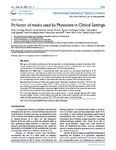Mostrar o rexistro simple do ítem
Fit factor of masks used by Physicians in Clinical Settings
| dc.contributor.author | López-López, Daniel | |
| dc.contributor.author | De Yñigo-Mojado, Borja | |
| dc.contributor.author | Madera-García, Javier | |
| dc.contributor.author | Becerro-de-Bengoa-Vallejo, Ricardo | |
| dc.contributor.author | Losa Iglesias, Marta Elena | |
| dc.contributor.author | Rodríguez Sanz, David | |
| dc.contributor.author | San Antolín, Marta | |
| dc.contributor.author | Calvo-Lobo, César | |
| dc.date.accessioned | 2020-11-24T11:11:56Z | |
| dc.date.available | 2020-11-24T11:11:56Z | |
| dc.date.issued | 2020 | |
| dc.identifier.citation | De-Yñigo-Mojado B, Madera-García J, Becerro-de-Bengoa-Vallejo R, Losa-Iglesias ME, Rodríguez-Sanz D, San-Antolín M, Calvo-Lobo C, López-López D. Fit factor of masks used by Physicians in Clinical Settings. Int J Med Sci 2020; 17(17):2696-2702. | es_ES |
| dc.identifier.issn | 1449-1907 | |
| dc.identifier.uri | http://hdl.handle.net/2183/26753 | |
| dc.description.abstract | [Abstract] Background: Usually, physicians use filtering respirators in clinical settings to a lesser extent than other simpler surgical masks. The study aim was to determine the fit factor of surgical and other types masks commonly used in clinical settings compared with FFP3 filtering respirators. Materials and Methods: A cross-sectional study was carried out recruiting a total sample of 78 physicians. Fit factor was measured to determine particles count into masks compared to particles count outside of the masks meanwhile physicians carried out a protocol composed by 8 exercises as well as the global fit factor total scores. First, fit factor was analyzed with the usual surgical masks used by physicians in clinical settings. Second, fit factor was determined with the proposed FFP3 filtering respirators. Results: Most participants (97%) used surgical masks. Statistically significant differences (P<0.001) with an effect size from moderate to large (d=0.61-1.00) were shown for fit factors in the different exercises and total scores between surgical and other masks (3.2±5.0) and FFP3 filtering respirators (40.7±37.8). Generally, FFP3 filtering respirators showed a higher fit factor in the different exercises and total scores compared to the commonly used surgical and other types masks in clinical settings. Conclusions: Despite most physicians used surgical masks in clinical settings, filtering FFP3 masks showed a higher fit factor in the different exercises and total scores compared with the used surgical masks and filtering respirators such as FFP1, FFP2 and other types in clinical settings. | es_ES |
| dc.language.iso | eng | es_ES |
| dc.relation.uri | https://www.medsci.org/v17p2696 | es_ES |
| dc.rights | Atribución 4.0 | es_ES |
| dc.rights.uri | http://creativecommons.org/licenses/by/4.0/ | * |
| dc.subject | Community Health Workers | es_ES |
| dc.subject | Filtration | es_ES |
| dc.subject | Masks | es_ES |
| dc.subject | Physicians | es_ES |
| dc.subject | Mascarillas | es_ES |
| dc.subject | Sanitarios | es_ES |
| dc.subject | Médicos | es_ES |
| dc.subject | Filtración | es_ES |
| dc.title | Fit factor of masks used by Physicians in Clinical Settings | es_ES |
| dc.type | info:eu-repo/semantics/article | es_ES |
| dc.rights.access | info:eu-repo/semantics/openAccess | es_ES |
| UDC.journalTitle | International Journal of Medical Sciences | es_ES |
| UDC.volume | 17 | es_ES |
| UDC.issue | 17 | es_ES |
| UDC.startPage | 2696 | es_ES |
| UDC.endPage | 2702 | es_ES |
Ficheiros no ítem
Este ítem aparece na(s) seguinte(s) colección(s)
-
GI-UDISAP - Artigos [196]






